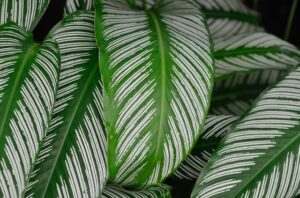The prayer plant (Maranta leuconeura) is a popular household plant among gardeners for its beautiful leaves. The plant is native to the Southern and Central American tropics.

How do you identify a Prayer Plant?
The leaves of the plant are sensitive to light. So, they withered during the night. There comes the fascinating name, prayer plant. The stunning foliage still welcomes the sun and blooms during the day. A mature plant will grow up to a height of 1 foot.
This outstanding appearance is due to its attractive green, light green, and yellow color mottles. In some varieties, the underside of the leaves appears in grey-green to purple-green. The tricolor leaves have a velvety texture. There is a popular try color variety with red veins. The plant is famously grown for its fancy leaves and thereby identifies as a hardy foliage plant and does not produce flowers.

How many types of prayer-plants are there?
The prayer plant belongs to the family: Marantaceae. However, people often call prayer plants for all the plants that come under this family. The true prayer plant is Maranta leuconeura. According to the records, there are more than 40 prayer plant types.
But only two types of prayer plants are widely grown as household plants. They are Erythroneura” and “Kerchoviana.”
- Erythroneura
This is the most popular type of prayer plant and has green-black foliage. The leaves contain feathers like red midrib and lateral veins. They are vivid and feathered with a light-yellow center.
- Kerochoviana
Also known as the rabbit foot, and has a vining nature. The upper surface of the leaves feels like velvet. The brown spotted leaves turn to dark green when mature. Due to its spreading growth, it is widely used as a hanging type. When they receive their original environmental conditions, they give small white color flowers.
- Kerchoviana Minima
A rare type of prayer plant with dark and light green blended leaves. The underside of the leaves is purple.

- Kim
This variety has light color leaves with cream-white color streaks and purple spots.
- Marisela
The trailing plant makes it perfect in hanging containers. The light green or the cream color herringbone-like patterns make the plant the most outstanding appearance.
How do you take care of a prayer plant?
If you provide the required environmental factors, the plant grows to a stunning view.
- Light
The prayer plant prefers lower light. It is better to place or hang the plant near a window and avoid direct sunlight. Exposure to sunlight will cause the leaves to fade their color and develop burns. Placing the plant in sunlight during winter will maintain its growth.
- Soil
The prayer plant tolerates a variety of soils. A potting mixture of peat moss, loamy soil, perlite, or coarse sand with an adequate drainage facility will make the best combination. However, the plant prefers an acidic soil of 5.5 to 6 Ph.
- Water
Prayer plant is sensitive to drought. It is critical to water frequently during the growing season. It will be hard to go on a dry spell. Both underwatering and overwatering are bad for the plant and result, in leaf yellowing, leaf fall, and fungal problems.
- Temperature and humidity
The plant likes to grow in a moderate temperature range from 210C to 240C. An adequate amount of humidity is essential for the foliage quality. Placing a plant near a humidifier or misting plant can help with this.
- Fertilizer
Determination of the correct fertilizer dose can be tricky. An all-purpose formula will enhance plant growth. You can use half of the recommended dosage to avoid fertilizer burns.
How do you propagate a prayer plant?
If you wish to propagate your prayer plant, there are a few options. You can go to a stem cutting during the spring to early summer. Cutting should be taken below the nodes and closer to the bottom of the stem. Plant the stem cutting in a potting mixture.
Even a broken part of the plant can give rise to a new plant. If you dip this end in a rooting solution, you can grow a new plant from it. With water changing daily, this small part will grow roots up to one inch. Now it is ready to plant in the soil mixture.

Is prayer plant good for indoor?
When the plant is in its natural habitat, the prayer plant prefers to grow as a cluster close to the ground level. As a tropical native, the plant often likes to grow in warm, humid conditions. Since plants do well under blotched light, it allows us to grow inside homes. Simultaneously the low spreading nature allows growing in hanging containers as well as the horizontal surfaces. The prayer plant is slow-growing, with no trouble with timely pruning and space allocation.
Compared to other foliage plants, the prayer plant can be a bit demanding. But the glamorous foliage plant deserves all this devotion. The slow-growing plant will survive for years and beautify your indoors.

